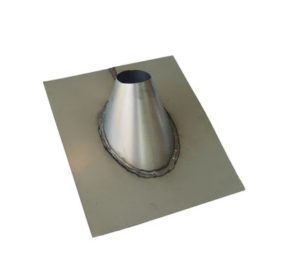Have you noticed small pipes or vents on your roof and wondered what a roof jack is? In Gaithersburg, MD, roof jacks are vital for preventing water damage and protecting your home. Many don’t realize their importance until leaks occur.
This post explains what roof jacks do, why they matter in Gaithersburg’s climate, and when to inspect or replace them.
What Is a Roof Jack

A roof jack, or a pipe roof jack, is a metal or rubber flashing that seals around pipes or vents where they exit your roof. Its main job is to stop water from leaking into your attic or walls, something especially important in Gaithersburg, where seasonal rain and snow can cause damage if your roof isn’t properly sealed.
You’ll find roof jacks around plumbing vents, exhaust pipes, and HVAC outlets. Without a roof jack, rainwater can sneak in around these openings, leading to costly repairs.
Why Are Roof Jacks Important for Gaithersburg Homes?
Gaithersburg’s climate means your roof faces heavy rainstorms, occasional snow, and temperature swings—all factors that can wear down your roofing materials. Roof jacks provide:
- Reliable waterproofing to keep rain and melting snow out
- Proper ventilation for plumbing and exhaust systems
- Protection against long-term water damage to your roof and attic
If your roof jacks fail or are damaged, you risk leaks, mold, and structural damage—problems no homeowner wants to face.
When Should You Replace a Roof Jack?
In Gaithersburg, roof jacks can last several years, but harsh weather can accelerate wear. Replace your roof jack if you notice:
- Cracked or dried-out rubber flashing
- Rust or corrosion on the metal parts
- Water stains or leaks inside your home below a vent pipe
- Gaps or lifted shingles near the vent
Types of Roof Jacks
Your local roofing contractors in Gaithersburg often use:
Rubber roof jacks
Flexible and effective for most plumbing vents
Metal roof jacks
Durable, ideal for furnace or dryer vents
Adjustable roof jacks
Useful for different pipe sizes or roof angles
Should You Hire a Pro to Handle Your Roof Jack?
If you’re comfortable on a ladder and have some DIY experience, you might replace a roof jack yourself. But in Gaithersburg, where roofs can be steep and the weather unpredictable, hiring a local roofing professional is usually safer and more reliable.
A pro will properly seal the roof jack and check surrounding shingles, giving you peace of mind that your home stays dry no matter the season.
How Roof Jacks Are Installed: A Basic Guide
Installing a roof jack involves a few important steps to ensure a watertight seal around your pipes or vents. Here’s a simplified overview of the process:
Remove old flashing
If replacing, carefully remove the damaged roof jack and any surrounding shingles without harming the roof decking.
Prepare the area
Clean the surface and make sure the pipe or vent is properly positioned.
Slide the roof jack under the shingles
The top edge of the roof jack flashing slides beneath the shingles above the vent to prevent water from seeping underneath.
Seal the edges
Use roofing cement or sealant to secure the edges of the roof jack and create a waterproof barrier.
Secure with nails
Fasten the flashing to the roof deck using roofing nails, avoiding the sealing area to prevent leaks.
Check the fit
Make sure the rubber boot snugly fits around the pipe or vent, and adjust if necessary.
Common Roof Jack Problems and How to Spot Them Early
Roof jacks are small but critical components that can cause big problems if they fail. Here are common issues and how you can catch them early:
- Cracked or brittle rubber flashing: Over time, sun exposure and weather can cause the rubber boot to crack, creating gaps for water to enter.
- Rust or corrosion on metal parts: Metal roof jacks can corrode due to moisture, weakening the seal.
- Water stains or damp spots: Notice any water stains on your attic ceiling or walls below the vent? This often signals a leak from a failing roof jack.
- Lifted or missing shingles around the vent: Shingles displaced by wind or poor installation can expose the roof jack and cause leaks.
- Moss or algae growth: Moisture trapped around roof jacks can lead to moss growth, which accelerates wear.
Regular roof inspections, especially after storms or heavy rain, help you spot these issues before they cause major damage.
Rubber vs. Metal Roof Jacks: Which Is Best?
Choosing between rubber and metal roof jacks depends on your specific needs and local climate conditions:
Rubber Roof Jacks
Pros: Flexible, easy to install, effective for most plumbing vents.
Cons: Can become brittle and crack over time due to UV exposure and temperature changes. Typically needs replacement every 5-10 years.
Metal Roof Jacks:
Pros: More durable, resistant to cracking, ideal for vents that get hotter (like furnace or dryer exhausts).
Cons: Can corrode if not properly coated or maintained, and sometimes harder to install due to rigidity.
Easy Roof Jack Care Tips
Maintaining your roof jacks can save you from unexpected leaks and costly repairs. Here are some simple tips:
- Regular Inspections: Check roof jacks at least twice a year and after storms for cracks, rust, or loose shingles.
- Clean Debris: Remove leaves, branches, and moss from around roof jacks to prevent moisture buildup.
- Seal Small Cracks: Use roofing sealant or cement to repair minor cracks or gaps before they worsen.
- Ensure Proper Ventilation: Keep vents clear of obstructions to prevent excess moisture buildup that can damage flashing.
- Prompt Repairs: Replace damaged roof jacks promptly to avoid water infiltration.
Routine maintenance helps prolong the life of your roof jacks and protects your home’s interior.
Why Proper Roof Jack Installation Matters
A roof jack may be small, but if installed incorrectly, it can cause significant problems:
- Water Leaks: Improperly sealed roof jacks allow rain and snowmelt to seep into your attic or walls, leading to water damage and mold.
- Structural Damage: Persistent leaks can weaken roof decking, rafters, and even your home’s frame over time.
- Reduced Energy Efficiency: Leaks and gaps around roof jacks can cause drafts, increasing heating and cooling costs.
- Costly Repairs: Fixing damage caused by poor installation is often much more expensive than the initial installation cost.
Conclusion
Roof jacks may seem small, but they play a big role in keeping your home dry and damage-free, especially in places like Gaithersburg, MD, where the weather can be tough on roofs. Knowing what a roof jack is, how it works, and when to check or replace it can save you from bigger repair bills down the line.
If you’re unsure about your roof jacks or spot signs of wear, it’s a good idea to ask a local roofing professional for help. They can inspect, repair, or install roof jacks properly, giving you peace of mind no matter the season.


